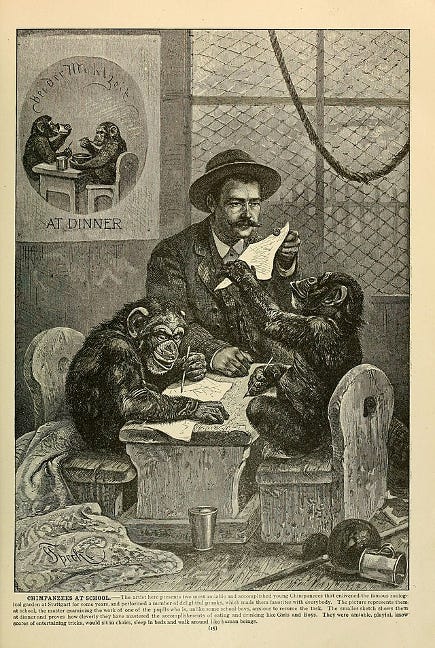Where did I leave my episode, again?
Hunter Gentry (Kansas State University) and Cameron Buckner (University of Florida)
Many theorists have noticed that humans are uniquely good at remembering. Granted, nonhuman animals can remember general things that are important to their lives. Foraging animals quickly learn which plants are tasty and which are poisonous; migrating animals remember specific routes to and from the location of their births, which they traverse with impressive accuracy years later. These forms of memory pertain to general properties and valences: a particular color is tasty, a particular smell is poisonous, a particular chemical gradient or mountain indicates home.
But humans are often thought to distinctively excel at episodic memories: memories of particular events that happened at particular times.
As readers of this page are likely all-too-aware, characterizing episodic memory with any more specificity than that risks controversy. But however this faculty is defined, there is little doubt that adult humans are the episodic recall stars of the Animal kingdom, remembering all sorts of details from all sorts of episodes, spaced out over spans of decades throughout their lives.
Why are humans so uniquely skilled at episodic memory? Some animal cognition researchers offer a straightforward explanation: because episodic memory is a distinctively human faculty that only we possess. Perhaps it requires special neural mechanisms or special kinds of mental experience to get the episodic memory system going, and other animals simply lack the relevant stuff.
This straightforward answer is challenged by the fact that as soon as we try to put our finger on the special prerequisites that are required for episodic memory, it seems that at least some animals actually have it, and perhaps even excel at it.
Could it be the hippocampus, the distinctive brain area on which episodic memory seems most dependent in humans? At least some form of the hippocampal formation developed in fish, and various hippocampal formations are widely distributed throughout the Animal kingdom.
Could it be the ability to form many rapid memory associations? Many animals also excel here. Clark’s nutcrackers, for example, can cache up to 98,000 pine nuts per season, and remember the location of at least most of those seeds up to 9 months later (they also have, for what it’s worth, really big hippocampi relative to their body size).

How about “autonoetic consciousness”, that fancy phrase for the “experience of reliving” that is supposed to accompany episodic remembering? Maybe that’s what’s missing in animals, but we have about as much evidence that animals lack autonoetic awareness as we have that other humans possess it–and anyway, if animals possess all the functional and anatomical precursors to autonoetic awareness, it isn’t clear why a special sort of feeling would allow us alone to do the special things that other kinds of memory with similar computational profiles, like semantic memory, don’t. Hopefully, if it’s so important, episodic memory amounts to something more useful than a particular form of relishing the past.
We offer a different answer as to why humans have a uniquely powerful episodic memory ability; but we warn you that the answer is a bit of a letdown. One of us has thought about animal cognition for almost three decades now, and tends to cynically think the most boring answer to these questions is usually the right one. Namely, humans alone have compositional language.
Why would compositional language enable distinctively powerful forms of episodic remembering?
Simple: because time travel is, at least for us at the present moment, impossible.
Well, let us slow down. Episodic memory is often glossed as a form of mental time travel, allowing us to reconstruct episodes from the past, and perhaps imagine similar episodes unfolding in the future. However, calling something “mental time travel” doesn’t explain how one reads the “mental road signs” to actually navigate around in that representational space. As anyone who has ever forgotten where they met someone, or where they put their car keys can attest, the right exits to the interchanges are not always so clear.

A difference between physical travel in space, and mental travel in time, is that the latter can’t involve any real refreshers. The past is gone, and it’s never coming back (and don’t even get us started on the future, which is even worse).
Spatial navigation, however, involves traveling through space, which allows us to not only retrace our steps and revisit places when our memory is foggy, but also look off into the distance and recognize spatial landmarks that can help orient us for navigation. In fact, in animal cognition experiments, the interesting forms of spatial navigation involve triangulating locations and routes with respect to such landmarks.
Through landmark-based orientation, we can locate ourselves on map-like representations of our environment—whether it be a physical external map, as of a subway system, or an internal mental map, like a mental map of one’s home neighborhood. Once we have a map-like representation of some space framed around some landmarks, we can do all kinds of fancy things with it—locate ourselves if displaced, disentangle ambiguous landmarks, chart novel routes to novel places, and efficiently access all kinds of things about which things are located in which places (like with, you know…memory palaces).
So, maybe the challenge with episodic memory is the difficulty of locating temporal landmarks. Spatial landmarks aren’t so useful for episodic memories, because many different events often occur in the same place. We often can’t remember what we had for breakfast this morning because we have had many other distinct breakfasts in the same location; we often can’t remember where we left our keys, because they are associated with so many different locations.
This kind of conflated associative content poses a ubiquitous addressing problem for any episode in either human or animal lives, because we both tend to return to the same places many different times. There is no unique temporal view or scent we can consult in a process of temporal remembering to distinguish associatively conflated episodes to access just the right one.
You know what does work, though? Temporal landmark words, particularly a finite, monotonically-ordered set of them that can be compositionally combined to uniquely index an infinite number of unique temporal moments.

With compositional landmark words, I might think about what I had for breakfast last Tuesday, or two weeks ago this Saturday. I might wonder what I ate for my birthday three years ago, or the first meal I had the first time I visited Spain. We can do this, because we can shuffle words into infinite combinations and decode their unique meanings; but no animals can, it seems safe to conclude, and not through any lack of trying.
But perhaps there is another way to induce limited forms of flexible episodic remembering in even nonlinguistic animals. Language proves useful for solving all sorts of other cognitive tasks, and simpler studies attempting to scaffold animal cognition by teaching them representational symbols provide some reasons for optimism.
For example, Thompson, Oden, Boysen, and colleagues performed a series of experiments assessing the ability of chimpanzees to learn the higher-order relational concepts “sameness” and “difference”, which untrained chimpanzees find very difficult to recognize in novel sets of stimuli pairs. They trained chimps to associate these higher-order relational concepts with either natural language words or novel colored tokens.
These symbol-trained chimps were successful at identifying these relations in novel sets of stimuli, unlike non-symbolically-trained conspecifics with familiarity on the same stimuli. The explanation for their success? The symbols were functioning like mental signposts, allowing the chimps to track these abstract relations using symbolic icons.
These sorts of experiments suggest a model for testing flexible addressing of episodic memories in animals. We imagine training animals to associate different kinds of actions with particular tokens. For instance, blue tokens might be paired with problem solving events where the animal has to solve some puzzles. Red tokens might be associated with eating events where the animal gets to eat some snacks.
The differently colored tokens might also differ in shape, which could be used to correspond to different temporal indices. For example, an earlier problem solving event might be associated with a blue circle, but a later eating event might be associated with a red square.
The test, then, would be to present the animal with a novel color-shape token, like a blue square, to see if they flexibly index a particular problem-solving event. If they can, then this would be good evidence that non-human animals have flexible episodic memory capacities, they just need to be cued in the right kind of ways. The trick is to generate compositional cue structures that are non-linguistic, but that can index different temporal indices.
Of course, these simple compositional tokens would very quickly exhaust their ability to index unique temporal locations, as we already know from animal language studies that even chimpanzees have a very limited ability to compositionally combine linguistic symbols into unique combinations. However, if the addressing explanation of the difficulty facing episodic remembering is right, then the flexible mental time travel abilities that humans enjoy are not off-limits to animals in principle. A fully human-level ability with compositional language would be the primary barrier to exhibiting human-level performance in episodic remembering.
This idea has a number of other philosophical and empirical sources of support, which if you are curious can be found in Gentry & Buckner (2019, 2024).






Interesting - it would seem that this account has certain similarities with that of Aristotle - cf Roark "Aristotle on Time"
p 145 "the memory has propositional content as opposed to objectual content .... acts of memory are reflexive in that the possessor of the memory himself figures in the content .... memory's content is intensional - a certain phantasm is taken to be about something else, to stand in place of ... a certain event that is represented by the phantasm."
p.164 "perceptual phantasms [which can occur for Aristotle in lower animals] come about through acts of perception, while deliberative phantasms [evoked in memory] come to be by acts of mind."
p.168 "He describes active recollection as a search for something preserved in memory, proceeding as a kind of inference, which is why only humans are capable of recollection, though many animals have memory."